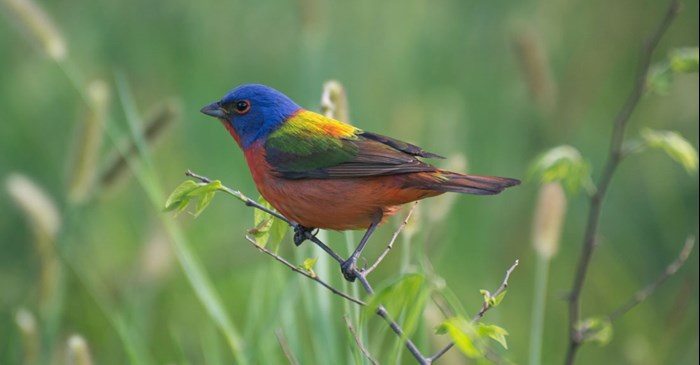Every autumn, some 350 North American bird species migrate. Their innate abilities to navigate are nothing short of impressive. Birds can hear low-frequency sounds such as ocean waves and approaching storms from hundreds of miles away, helping them steer clear of foul weather. Scientists also believe birds detect magnetic fields in the earth, giving them an inner compass to guide their journeys.
Sometimes, however, the journey doesn’t go as planned. Here's one example:
During the fall of 2015, a male Painted Bunting caused a frenzy among local media and Brooklyn birders when he was spotted foraging in Prospect Park - thousands of miles from any breeding or winter territory, he was quite out of place! These rainbow-colored birds spend summers in the south-southeast region of the U.S., including Texas, Louisiana, Arkansas, and Oklahoma, migrating to Florida and Mexico in the winter. He quickly achieved “celebirdy" status, complete with rope barriers, photographer pit, write-ups in national publications and, of course, his own Twitter account.
Some American birds actually end up in the United Kingdom along with other parts of western Europe. The Baltimore Oriole, Rose-breasted Grosbeak, Brown Thrasher, Common Redstart and Summer Tanager are just some American songbirds that land a mention in Britain’s annual report of rare birds.
When birds get lost during fall migration and end up in an entirely new region or even continent, ornithologists refer to them as vagrants. Here are three possible explanations for vagrancy in birds:
- Those approaching storms they detect from afar can send them off course. In circumventing these pressure systems, they can end up in odd places.
- Some become stowaways on freightliners. The White-throated Sparrow and Dark-eyed Junco are two such examples of American songbirds who have ended up across the Atlantic.
- Their inner navigation system flips into reverse, sending them in the opposite direction of their tropical winter home. This is called reverse migration, and it’s more common in juvenile birds making their journey for the first time. In some cases, that means yes, these little birds do end up crossing the Atlantic Ocean. (When even small songbirds have enough fuel, they are capable of traveling great distances.)
So what happened to the famed Painted Bunting of Brooklyn? He was last seen right after New Year's in 2016. Since he wasn’t banded, there’s no way to know where he went or what happened to him. One possibility is he detected an approaching winter storm and took off, hopefully for a warmer climate.
Fall is prime time for keeping your eyes and ears open for sightings of something new. It can happen when you least expect it. So take pictures, follow on Twitter, and keep your bird feeders well filled with high-quality seed to keep our feathered friends fueled for the long journey. Lyric Supreme Wild Bird Mix contains more than 50% sunflower seeds and nuts, offering a welcoming feast for a wide range of travel-weary birds.
